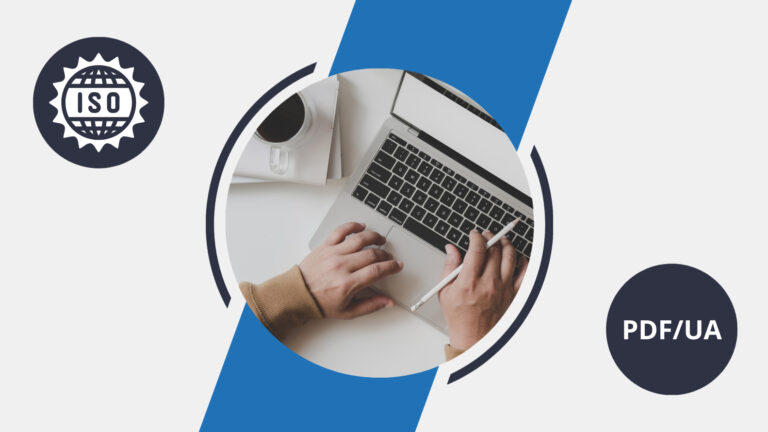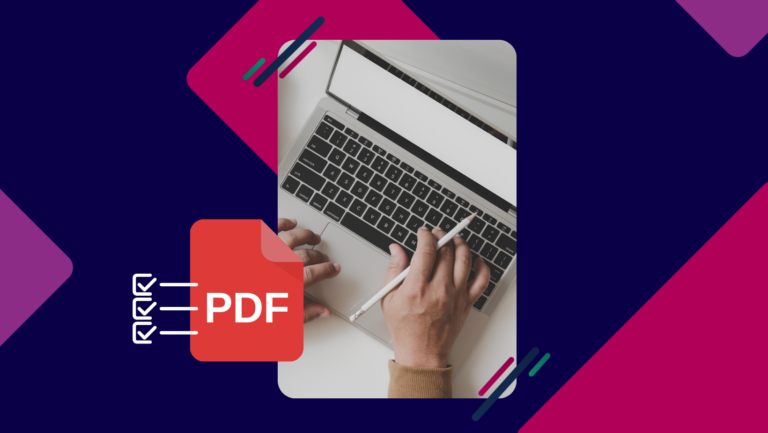Creating accessible documents is not only a matter of inclusion but also a legal requirement in many juridictions. In this article, we explore the existing methods and tools for designing accessible documents, specifically PDF files. Discover why creating accessible PDFs is essential, learn techniques to improve their accessibility, and explore the most effective tools to facilitate navigation for people with disabilities in these documents.
The accessible PDF: what is its importance?
The importance of accessibility for PDF documents is crucial, as these documents play an essential role in our digital lives.
What is an accessible PDF? Or the accessibility of office documents?
An accessible PDF ensures smooth navigation, understanding, and interaction for users with visual, auditory, or physical difficulties.
PDF files are widely used on the Internet, from reports, contracts, and invoices to magazines and minutes, to name just a few. However, the PDF format is not natively interpretable by screen readers like NVDA or Jaws.
Without proper optimization, it leads to inequalities in accessing information. Hence, the importance of capitalizing on digital accessibility, adopting inclusive practices when developing PDF files.
Reminder: definition of digital accessibility
Digital accessibility ensures better access to information for people with disabilities. This promotes equitable dissemination of information regarding the use of websites, tools, and digital technologies.
Different standards and regulations have been established to meet this objective, including EN 301 549 V3.2.1, WCAG, and RGAA at the European, global, and national levels, respectively.
The PDF/UA regulates the accessibility of accessible PDF documents.
→ See the comparison of WCAG-PDF/UA standards
Why make your publications accessible?
As mentioned above, the approach to accessibility in the broader sense promotes a more diverse and inclusive digital landscape.
To better address the challenges of PDF accessibility, it is essential to consider these three main issues:
- The legal challenge – meeting legal requirements for digital accessibility
- The technological challenge – maximizing the production of accessible PDFs
- The societal challenge – continually improving the CSR (Corporate Social Responsibility) strategy
What technologies are used by people with disabilities to navigate a PDF document?
Screen readers and text-to-speech software
Screen readers and text-to-speech software are essential to ensure the accessibility of PDFs for individuals with visual impairments.
Here are some key features of screen readers and text-to-speech software:
- Text-to-speech conversion: They transform written content into spoken speech to enable users to understand the presented information.
- Intuitive navigation: They provide voice commands and keyboard shortcuts to facilitate navigation through documents and on the web.
- Compatibility with various platforms: They work with different operating systems and web browsers to ensure optimal accessibility.
The tools for magnification and color contrast
These tools allow users to adjust text size, zoom level, and colors to make digital documents more readable.
Among the key features are:
- Text magnification to enlarge document content for easier reading.
- Color settings adjustment to modify colors and contrasts for improved readability and reduced visual fatigue.
- Customization of preferences: They allow users to set and save their preferences for text size, colors, and contrasts for a personalized experience.
Good to know:
The integration of navigation shortcuts and keyboard functionalities into assistive technologies helps facilitate the use of assistive technologies and access to PDFs. These shortcuts enable users to quickly perform common actions, such as navigating between pages in a document, searching for specific keywords, or opening and closing files.
Best practices for creating accessible PDFs
Creating accessible PDFs involves a comprehensive understanding of technical, graphical, and editorial criteria. The goal is to ensure the conveyance of all components of the PDF in an audible, consistent, and understandable manner.
Creating accessible PDFs from the source document
This approach is not only faster but also more effective than tagging the document later in Acrobat. In practice, it involves establishing a logical reading order in the source document and ensuring that all elements are correctly labeled and organized.
The use of appropriate headings and alternative text
Headings should be clearly defined and structured hierarchically. This practice helps users navigate the document easily and understand its content.
Alternative text should be provided for non-text elements. This allows screen readers to convey the information contained in these elements to visually impaired users.
Note: It is not necessary to add alternative text to decorative images if they do not provide any additional value to the user.
Testing the accessibility and compliance of your PDFs
It is essential to assess the performance of your PDF documents when using assistive technologies such as screen readers.
Here are some key points to consider during testing:
- Ensure that all text is readable and understandable by assistive technology.
- Verify that all non-text elements are properly tagged with alternative text.
- Ensure that the structure and navigation of the document are logical and intuitive.
DocAxess solutions: ACCESSIBLE PDF
DocAxess – Accessible PDF provides an alternative solution to conventional, sometimes tedious and time-consuming methods
The strengths:
- Simplicity and speed, as this technology radically simplifies the task of making your documents accessible to all.
- Used on an industrial scale to provide access to PDF content for visually impaired or blind users.
- Alignment of documents with various French, European, and international standards and legislation.
The technology used: XML tagging/coding allows screen reader users to structure the reading order of the document.
Digital accessibility is essential to ensure equal access to information on the web, including PDF files. Creating accessible PDFs involves following the best practices outlined in this guide. By prioritizing digital accessibility, we can create a more inclusive online environment for all users.












